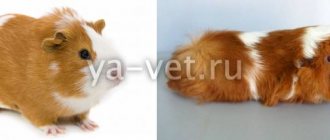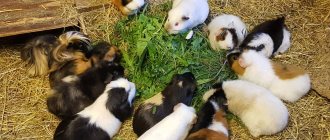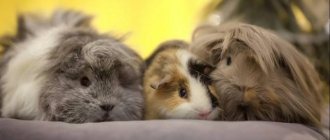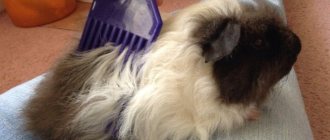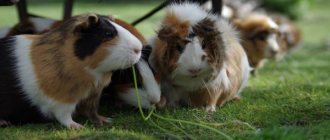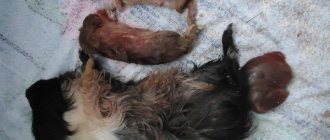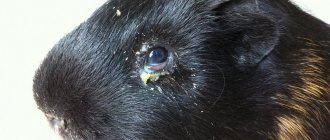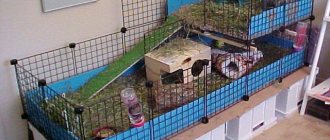- home
- Guinea pig
02/07/2019 Despite their name, guinea pigs are not considered the most water-consuming animals. Nevertheless, the owner should know why their animal suddenly begins to drink a lot, or refuses to drink at all. What is happening to them and why are they behaving this way?
Norm
About 250 ml is enough for one pet. Although, as a rule, there is no specific dose. Each animal consumes as much liquid as it needs, depending on its age and nutrition. The main thing is not to have enough.
You need to put a drinker in the cage, preferably a special ball or rod drinker, which differ in the type of valve. There is no difference, the first ones are just more popular. You should also pay attention to the fastenings. Plastic ones that are attached to the grille are the best option. There are also suction cups and wire ones. But they have their drawbacks: the first ones do not hold securely, while others create noise while drinking.
It is not recommended to simply pour water into a bowl. While running, an animal can easily turn it over, get wet and catch a cold.
Females who are expecting babies and nursing ones drink more than usual. Often leftover food gets into the water and it quickly spoils. Therefore, it must be changed daily. You can use filtered, still bottled water, but the temperature should be at room temperature. You can boil water, cool it to the required degrees and then pour it. Raw tap water, even settled water, is not suitable for drinking.
Some owners see that the animal does not seem to need it and stop giving water. But this cannot be done. All guinea pigs need to drink, some not enough, some more. A lack of fluid in the diet can lead to malfunctions of the pet’s internal organs.
First aid and treatment
Urgently show the animal to the ratologist. It is necessary to quickly find out the cause and prescribe the correct treatment. There is not a doctor of this qualification in every city, and he does not always see you. The pet has at most 16 hours. Therefore, you need to be able to feed a guinea pig artificially. Force feeding begins when the hunger strike lasts more than 8 hours. There are several feeding options:
- Children's fruit or vegetable puree without prunes. The serving is 20% of the usual diet.
- Soaked food in grass granules.
- Wheat bran porridge or rolled oats with water are suitable.
- You can use baby porridge without milk.
- If the animal cannot take a bite, you need to grate vegetables, for example, pumpkin or carrots, on a fine grater.
The pet must be fed through an insulin syringe without a needle with a cut off tip. Thus, food will enter the intestines, albeit in a small dose. You can add a little ascorbic acid to increase the level of vitamin C in the body. Feeding should be done every 3 hours. Even if after a few days the guinea pig begins to eat on its own, take it to the doctor as soon as possible.
Why does my pig drink a lot of water?
Reasons why your guinea pig drinks a lot of water. It's possible she might have a fever. Another motive that causes thirst is that for a long time the food contains dry food: grain mixtures, hay, and there is little fresh grass and vegetables in the diet.
At home, especially in winter, when the air becomes dry due to heating, the animals' need to drink may increase.
It happens that a pig drinks water just to keep itself busy. In this case, you need to put the drinker only for a while.
Alternatively, the drinking bowl is leaking. Or if the cage is small, then the rodent can drink water out of nothing to do. This means that you need to change it to a more spacious one, check the sawdust under the drinker to see if it is wet. Sometimes the pig drinks carelessly, spilling some water.
Drinking too much can be caused by stress. If the pig has recently appeared in the apartment and the environment is new and unusual for it.
Skin diseases
Skin diseases of guinea pigs are most often associated with improper housing and feeding conditions and are provoked by various skin parasites: mites, lice, lice, as well as fungi and allergies. The first signs are itching and the appearance of lumps on the skin, ulcers, most often purulent, scratching and hair loss. Skin diseases are not as safe as many people think.
Severe itching can lead an animal to exhaustion, heart attack and death.
It is possible to determine exactly why a guinea pig is itching and what type of parasite is causing the itching only in a veterinary clinic using skin scrapings. Most often, treatment consists of treating the animal with special shampoos. However, in case of severe damage, antibiotics and probiotics may be prescribed.
What to do
Drinking a lot is not harmful. Pigs differ from other rodents in that they drink large amounts of liquid and relieve themselves, especially if there is little succulent food. But it often happens that animals simply spill water - by accident or while running due to shaking, it spills itself. To prevent this from happening, you need to place a ceramic stand under the spout of the drinker, pour filler onto the bottom of the cage and cover it with sawdust.
And don’t worry about your pet drinking a lot. If the animal is healthy, it regulates its own drinking rate. More succulent food in the diet will reduce the dose consumed.
Source
How much should you drink when sick?
Doctors often recommend drinking plenty of fluids while prescribing medication. But it is not always clear what is hidden under this concept. How much water should you drink to avoid fluid deficiency in the body? Physiological specialists have calculated how much a person with coronavirus infection needs to drink. According to research and calculations, on average, for every degree of temperature increase, it is necessary to increase the intake of liquid in the amount of 10 ml per kg of weight. Thus, if you have a high fever (approximately 39°C), you will need half a glass or a glass of water every hour.
Interesting! Japanese scientists studying coronavirus infection have concluded that you need to drink a few sips every 15 minutes. This helps to avoid drying out of the mucous membrane and reduces the risk of infection in the respiratory tract.
Water norm
There is no exact norm for any living creature. There is only a recommended dosage. For guinea pigs, a quarter of a liter per day is enough. But for the most part, animals determine their own need for fluid. The amount of water drunk per day depends on the conditions of detention, age, physical activity, and nutrition. The main thing is that there is always water. The water must always be served clean and at room temperature to prevent it from catching a cold. Monitor how much water your guinea pig drinks per day. Based on these observations, it will be easier for you to regulate the water supply. Choose the right drinking bowl and place for it in the cage. Guinea pigs are quite active animals. While moving, they can spill water, get wet, and remain without a drink until you arrive. And if they get caught in a draft with wet fur, they can easily get sick. If you see that your pet rarely drinks water, then in any case change it with the same regularity. Remember that a lack of fluid in an animal has a very detrimental effect on it.
Liquid intake rate
Do not worry ahead of time, because increased thirst does not always mean the presence of a serious pathology in the cat’s body. Veterinarians do not have water consumption standards. Indicators depend on many factors - age, physiological state, climatic conditions, nutrition, etc.
The amount of moisture required for the body can be calculated approximately: 0.03 ml of liquid per 1 gram of cat’s body weight. Moreover, you need to count not only water, but also wet food, milk, broth, etc.
Veterinary experts say that each cat has its own water consumption rate. You can determine that she has enough fluid by the animal’s behavior. If the cat is cheerful and active, eats with appetite and does not lose weight, then everything is in order with his health.
Why does he drink a lot?
There are many reasons why guinea pigs drink heavily. One of them is pregnancy in a female. In this position, the guinea pig drinks a lot of water. Another reason is illness. A hamster may drink a lot due to elevated body temperature. This replenishes all the necessary elements in the body. In winter, when houses are heated and the air dries out, guinea pigs' need to drink increases. In winter, pigs' diet changes. For the most part, they are fed hay, formula, and dry food. Therefore, it is very important to feed your guinea pigs in a balanced manner, adding more vegetables, herbs and fruits. They contain moisture, which replenishes their fluid. Hyperactive rodents that run and play a lot also require plenty of fluids. The animals are quite sensitive and can experience overexertion. This is also the reason for frequent drinking in the animal.
Sleep disturbance and hiccups
Guinea pigs are very active animals. They sleep several times a day and little by little, and in case of danger or in an alarming situation, the guinea pig sleeps with its eyes open. Young animals spend less time sleeping, but older animals spend much more time sleeping. If your guinea pig lives alone, it may also sleep longer. Sleep disturbances are usually caused by a nervous state, problems with skin parasites and improper feeding. You can identify problems with sleep in an animal by changing behavior - the guinea pig becomes more active, loses appetite, may show aggression and refuse offered treats. It is not the effect that should be treated, but the cause - examine the animal, donate blood for analysis and scrape the skin to identify skin parasites.
Sleep problems sometimes cause your guinea pig to hiccup.
Another cause of hiccups is a cold. Signs of a cold include lethargy, decreased appetite, elevated body temperature and heavy breathing. Purulent and mucous discharge is possible from the eyes and nose. Colds are treated with Sulfazine or Sulfadimezine 0.1 mg per kilogram of guinea pig weight three times a day.
Allergies also cause hiccups. Allergies are most often caused by dust contained in sawdust or hay, or too sweet or sour foods. In addition to allergies, problems with clean drinking water can also cause hiccups. The daily amount of water consumed by a pig is approximately 100 ml. However, if yesterday a guinea pig drank more than normal, and today it hardly comes to the drinking bowl, this is not a sign of concern. Sometimes the difference in water consumption can be explained by changes in weather and temperature, changes in mood and the abundance of succulent food in the feeder. But if the animal is thirsty and the drinking bowl is empty, then hiccups may occur.
What to do
If you see that your pet has suddenly begun to drink a lot and this is accompanied by behavior that is uncharacteristic for it, then contact your veterinarian. Explain the symptoms and how much fluid your guinea pig drinks. But by and large, it is not dangerous to health. On the contrary, the more an animal drinks, the healthier and more active it becomes. Animals regulate their need to drink; owners only need to ensure constant access and availability of water in a bowl.
Feed and water your pet as usual. The body's abilities and their needs are absolutely individual for each animal. Choose an approach that suits the needs of your animal and it will stay with you and delight you with its presence for a very long time.
Source
Injuries
If your guinea pig falls on the floor or the soft surface of a chair or sofa, it can cause injury. The animal should be examined immediately for bleeding, lameness, or swelling of the legs. Sometimes it takes a few minutes for the animal to realize that there is a problem, so the breeder should watch the guinea pig for a while. If an animal falls from a height (escapes from the hands and falls to the floor), this can lead to broken limbs. Sometimes the fall ends more sadly: the guinea pig's hind legs give out or it cannot lean on its front legs. This indicates a spinal fracture. The animal must be taken to a veterinarian immediately and x-rayed.
If after the fall the pig does not limp, but slight swelling appears, it is removed with injections:
- Cerebrolysin,
- Mexidol,
- Prednisone.
The drugs are administered 0.1 ml per kilogram of the animal’s weight intramuscularly for a week. In addition to medications, it is necessary to massage the injured limbs.
What should an owner do if a guinea pig drinks too little/too much water?
Content
The owner of a guinea pig needs to know how much water the pet usually drinks per day. After all, if the standard volume of fluid consumed changes significantly, the owner should notice this - this may indicate health problems.
Let's find out how much a guinea pig usually drinks, and also look at the reasons why it refuses water or, conversely, drinks too much.
Diseases dangerous to people
Guinea pigs can be a source or carrier of diseases that are dangerous to humans. You can become infected with skin or intestinal parasites from an animal. Roundworms cause strongyloidiasis, and giardia causes giardiasis. Liver fluke can cause severe liver disease, which in most cases is fatal. From a guinea pig, a breeder can acquire diseases caused by bacteria and viruses: salmonellosis, tuberculosis and leptospirosis. The most commonly transmitted skin disease is lichen. Regular flu can be transmitted both from the breeder to the animal, and from the animal to the breeder. Avoiding infection is not difficult: you need to keep the cages clean, wash your hands after each cage cleaning, as well as after interacting with the animal, and avoid getting saliva or animal hair in your mouth. Any illness in an animal - use a disposable medical mask.
How much water does a guinea pig drink normally?
Wild guinea pigs drink quite a bit of water, since they feed mainly on succulent grass, which saturates the body with fluid. At home, it is not always possible to feed such a pet with its usual food, so it is necessary to install a drinking bowl in the rodent’s house.
There is no exact intake rate for guinea pigs. However, the recommended daily fluid volume is 200 ml. However, each individual determines for itself how much water it needs.
The amount of fluid consumed per day depends on the following factors:
- nutrition;
- physical activity;
- conditions of detention;
- age.
The main task of every guinea pig owner is to provide their pet with constant access to fresh drinking water at room temperature. It is recommended to install drinking bowls with a volume of 250 ml or more in the rodent's cage so that the pet can drink as much water as he wants.
Deadly diseases of guinea pigs
Despite a strong immune system, your pet can get sick. The reason may be lack of care, lack of vitamins or a sudden change in diet. The most dangerous diseases that lead to the death of a pet are viral infections.
Enteritis
The lack of vital nutritional components (hay, grass) causes an infectious disease, the causative agent of which is Escherichia coli. The bacillus develops rapidly in the animal’s intestines and digestive organs.
A bloated belly feels hard to the touch
First symptoms:
- Bloating.
- Refusal of food and drink.
- Fever.
- Diarrhea with blood clots.
- Wheezing in the lungs.
- Paralysis of limbs.
- Body convulsions.
Without prompt veterinary intervention, the animal dies from loss of fluid in the body.
Salmonellosis
A virtually incurable disease. The source of infection is animals, food with a large amount of protein or water contaminated with salmonella bacilli. The first sign is:
- Complete refusal of the animal to eat and drink.
- Profuse salivation.
- Diarrhea.
- Intermittent breathing.
- Heat.
- When examining the abdomen, bloating is observed.
Without the help of a specialist, the rodent dies within a day. At an early stage of the disease, the pet can be saved; delay involves euthanasia. It must be remembered that the disease is contagious to humans. In any case, disinfection of the room and cage is required.
Pseudotuberculosis
An extremely dangerous disease transmitted through contaminated food or drink. The disease caused by bacteria is fleeting and can affect all inhabitants of the cell. Manifests itself in symptoms:
- Loss of appetite.
- Lethargy.
- Increased body temperature.
- Severe diarrhea.
- Convulsions progressing to paralysis of the legs.
Pseudotuberculosis cannot be cured. The animal dies from lack of fluid in the body and paralysis.
Pneumonia
Pets with weakened immune systems and vitamin deficiencies are prone to the disease. Pathogens include disgusting rodent maintenance and poor quality nutrition, as well as infection from a sick owner.
The pig may not eat at all or eat little by little
The first signs of respiratory disease are:
- Refusal of food.
- Weakness and indifference.
- Frequent drinking.
- Discharge of pus through the nasal sinuses, which the animal tries to get rid of on its own by wiping its nose on the bedding, or trying to clear its nose with its paw.
- Shallow, rapid breathing.
- Heat.
- Short convulsions.
When characteristic symptoms appear, the rodent must be isolated from people and animals. A timely visit to the veterinarian and quick medical assistance can save your pet.
Why doesn't my guinea pig drink water?
Sometimes the pet completely refuses to drink fluids. If he remains active and is in a good mood, then you should not draw hasty conclusions, because refusing to drink does not always indicate health problems.
The reasons for lack of thirst can be very diverse.
Problems with water or drinking bowl
Guinea pigs can easily recognize poor quality water. They will not drink contaminated, stagnant or too cold liquid with an unpleasant odor. Therefore, the owner must change the water in the drinking bowl daily.
An animal may well refuse to use the drinking bowl for one of the following reasons:
- The container is dirty. Every day, when changing the water, you should thoroughly wash the drinking bowl so as not to spoil the fresh water.
- The drinking bowl is installed very high. The water container should be hung at the level of the rodent's muzzle so that it does not have to lift its head too high.
- The drinker is faulty. It is necessary to periodically check the functionality of the drinker, since water may not flow due to a clogged tube, a jammed ball, or the container itself has moved to the side.
- At her previous place of residence, the guinea pig got used to drinking water from a bowl, and not from a drinking bowl. The intelligence of these rodents is quite well developed, so he just needs to give him time to get used to the drinking bowl. In addition, they are able to smell water and can find where its source is. You can also tell your pet how to use the device: twist the ball so that water drips from the drinking bowl.
Drinking regime and nutrition
It is more convenient to feed a guinea pig with ready-made concentrated food, at the rate of 20 g per kilogram of animal weight. If you give crackers, white bread or crispbread as a treat, you should know that such food is part of the finished food. Therefore, it must be given in accordance with the permissible volume.
It is worth adding 50 grams of succulent feed and fresh hay to the finished concentrated mixture. This type of feeding allows you to maintain the pig’s health at a high level, since all food has a balanced composition and is rich in vitamins and minerals.
Water is of great importance for rodents. Therefore, it is worth washing the sippy cup every day and pouring fresh, clean water. As vitamins, you can add ascorbic acid to the sippy cup at the rate of 30 ml per 100 ml of liquid. Vitamin C solution can be obtained from a veterinary clinic or pharmacy.
Possible diseases
In some cases, the reluctance to drink water is due to the fact that the guinea pig has excess fluid in its body, which leads to internal swelling. Typically this condition is a symptom of the following diseases:
- heart attack;
- urolithiasis disease;
- pneumonia;
- problems with blood vessels;
- renal failure.
With such ailments, the guinea pig’s body tries to get rid of the accumulated liquid in it, so the pet does not drink anything.
Important! If the rodent suddenly becomes lethargic and does not eat or drink anything, it is necessary to show it to a doctor as soon as possible, since without timely medical care the pig may die.
To reduce the likelihood of your pet developing various diseases, compliance with the care and maintenance conditions necessary for these rodents will help:
- A properly selected balanced diet.
- Avoiding stressful situations.
- Creating a comfortable environment in the cage.
- Maintaining physical activity.
- Creating a suitable climate in the room where the cage is located.
Diagnostics
Don't hesitate if you see an animal acting strangely.
Take him to the veterinarian immediately - only he will be able to recognize the disease.
But, of course, you must be able to distinguish a sick rodent.
Diseases found in guinea pigs are divided into several types:
- defects caused by heredity;
- a number of parasitic diseases;
- diseases caused by improper feeding, as well as the composition of food feed;
- infections;
- all kinds of mechanical injuries.
Why does a guinea pig drink a lot of water?
Guinea pig owners may also be concerned that their little pets drink too much water. There are many reasons for this:
- Pregnancy and lactation period.
- Hot weather outside in summer or heating on in winter when the indoor air is too dry.
- Increased body temperature due to any disease.
- Changing the diet, especially in winter, when the proportion of fresh herbs, fruits and vegetables, which contain more liquid, is reduced.
- Too active pastime.
- Stress.
Interesting! Sometimes guinea pigs often drink water when the water bowl is leaking or even out of boredom, for example, if the cage is too small for them and they have nothing to occupy themselves with. In this case, it is recommended to replace the drinker with a new one, and also purchase a more spacious cage.
The owner of a guinea pig must carefully monitor his pet in order to notice the slightest changes in behavior in time. When an animal refuses water or, conversely, consumes excessive fluid, you must first understand the reason for this behavior. Indeed, in some cases, reluctance to drink water is a symptom of diseases that can take the life of a guinea pig.
Source
Pneumonia in a guinea pig
Pneumonia in a guinea pig can be infectious or a complication of a cold, rhinitis, bronchitis or pulmonary edema. Most often, pneumonia is observed in weakened animals and young animals in the spring and autumn. Pneumonia can be caused by keeping furry pets in a draft, in a damp or cold room, changes in temperature and humidity, and improper transportation. Concomitant factors are an unbalanced diet, a lack of vitamin C in the animal’s body, and a lack of sufficient amounts of fresh herbs, vegetables and fruits in the small animal’s menu.
Acute and chronic pneumonia occurs in guinea pigs. The acute form is dangerous due to its rapid current. The pet has a high fever, intoxication and exhaustion. He may die within 3-4 days from the onset of the disease. In advanced cases, treatment is not always effective. The chronic form does not have a clearly defined picture. At the same time, it significantly shortens the life of your beloved pet. Pneumonia reduces the immunity of the funny animal, which often begins to suffer from infectious and contagious diseases and loses a little weight.
The development of pneumonia in a guinea pig is indicated by the following characteristic symptoms:
- refusal of food and water;
- dry or wet cough, depending on the form and stage of the disease;
- heavy, hoarse breathing with whistling and gurgling, the animal experiences shortness of breath, and when inhaling, the sides characteristically rise;
- inactivity, lethargy, a depressed animal sits, ruffled, in one place or lies, does not respond to treats or the owner’s voice;
- the small animal sneezes, grunts, sniffles, viscous purulent discharge is observed from the nose and eyes;
- the nose is covered with dried crusts of pus, the eyes are red, swollen, the palpebral fissure sticks together and purulent contents accumulate in the corners of the eyes;
- the coat is dull, tousled, stuck together;
- The guinea pig sleeps often and for a long time.
It is necessary to treat your pet at the first signs of illness under the supervision of an experienced specialist. An insidious pathology may have hidden symptoms. Often there is a significant improvement, followed by a relapse, deterioration of the condition and death of the beloved animal.
Treatment
If your guinea pig wheezes, your veterinarian will prescribe a course of antibacterial or sulfonamide medications. These include: “Baytril”, “Sulfazin”, “Sulfadimezin”. Medicines are used in a course only after determining the animal’s body’s response to the drug. Simultaneously with antibacterial therapy, it is necessary to give the patient probiotics: “Linex”, “Vetom”, “Bifidumbacterin”.
Every day it is necessary to clean the animal's nose by cleaning the muzzle from crusts of pus and rinsing with a chlorhexidine solution. After drying the nasal planum, it is recommended to blow Streptocid powder into each nostril twice a day.
In case of eye inflammation, it is necessary to wash the animal’s eyes twice a day with sterile saline solution, followed by instillation of anti-inflammatory drops “Tsiprovet”, “Tsipromed”.
To eliminate a cough, you need to give your pet expectorant mixtures of anti-inflammatory herbs or give the animal a drop of Bromhexine baby syrup.
To restore immunity and increase the body's resistance to colds, the pet is prescribed an increased dose of ascorbic acid with glucose, gamavit and echinacea tincture.
An increased amount of green grass, vegetables and fruits should be introduced into the diet of a sick pet. In case of complete refusal of food, the animal must be fed paste-like food from an insulin syringe without a needle. Small portions should be given 5-6 times a day.
Main diseases of guinea pigs and how to cope with them
Guinea pigs are charming and cute animals, which are often acquired when children, realizing that they cannot get a cat or dog, ask to take at least some animal. With proper care, pigs can live up to 10 years. Despite the fact that they seem like primitive and stupid animals, pigs turn into real family members. Pigs are quite unpretentious and easy to care for. But, like any animal, a guinea pig requires attention to its health, living conditions and can get sick. Timely identification of your pet's health problems and the correct response can speed up recovery, and in some cases, save the animal's life.
Eye diseases
One of the most common diseases is conjunctivitis. Conjunctivitis in guinea pigs is caused by infection, chemical irritants and physical injury. The disease can affect one eye or both at once. The disease has three stages, each of which has its own symptoms:
- First stage. Swelling, redness of the eyes, sticking of eyelashes,
- Second phase. Discharge of pus from the eyes, the eyes stop opening,
- Third stage. Clouding of the cornea and loss of vision.
If a guinea pig gets sick with conjunctivitis, then first aid will be provided by Albucid solution, which removes mucous and purulent discharge from the eyes. After the eyes have been washed, it is necessary to put Tetracycline or Hydrocortisone ointment under the eyelid. The area around the eyes should also be lubricated with the same ointment. If clouding of the cornea is observed, Calomel should be injected into the affected eye, after mixing it in equal proportions with powdered sugar. The procedure is repeated twice a day.
Eye diseases also include keratitis. It causes a violation of the integrity of the cornea of the eye, and the cause is damage to the mucous membrane by prickly grass or twigs. Keratitis is treated with Fluorescein solution and eye drops. Additionally, you can use any glucose-containing eye ointment.
Diseases accompanied by lack of thirst
A guinea pig refuses water only when there is an excess of fluid in its body. This situation is often observed due to edema. Diseases leading to edema in guinea pigs:
- kidney diseases, especially urolithiasis; cardiovascular diseases, previous heart attack; pulmonary edema due to pneumonia.
With these diseases, the guinea pig's defense mechanism turns on. The less water she drinks, the faster all the moisture will leave the body.
When your guinea pig does not drink water or go to the toilet, you may suspect urolithiasis. It is a metabolic disorder in the body, resulting in the formation of stones of various natures in the kidneys. In the future, these stones cause a number of symptoms:
- change in urination; pain syndrome; loss of appetite; vomit.
The main symptom is refusal of water. In the future, kidney stones can move along the ureter, thereby injuring it and clogging the lumen. A characteristic sign of a stone in the ureter is bloody urine. Before the stone passes from the kidney into the ureter, it can provoke an attack of renal colic.
If treatment is not carried out, the stone then moves down the ureter and enters the bladder. The guinea pig begins a period of imaginary well-being, as the stone simply floats in the bladder. Well-being continues until a stone blocks the outlet of the bladder. In this case, a clear clinical picture appears:
- the animal completely refuses water and stops going to the toilet; sharp, pronounced pain syndrome (the animal rushes about and cannot find a place for itself); enlargement of the abdomen due to stretching of the bladder; severe intoxication of the body (repeated vomiting, lethargy).
If you do not visit a veterinarian and do not begin urgent treatment, there is a risk of death.
Another disease in which a guinea pig does not drink water and is lethargic is a complication of myocardial infarction - heart failure. This disease occurs more often in adult animals. Heart failure is a consequence of untreated myocardial infarction or improper adherence to veterinarian prescriptions.
Main manifestations of heart failure:
- lethargy and apathy of the guinea pig, rare monotonous movements around the cage; swelling of the whole body, especially the abdomen and limbs; complete refusal of food and food; rare trips to the toilet; dry ears; deterioration of coat condition.
This disease is incurable. Therefore, it is better to prevent it. Prevention consists of preventing stress in the animal, proper balanced nutrition, and the possibility of active life. Guinea pigs that lead a sedentary lifestyle are at risk. Therefore, inside and outside the cage, the pet should have the opportunity to run and move around.
By the way, do you know how to determine the breed of a guinea pig? Look, it's interesting!
